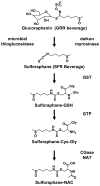Bioavailability of Sulforaphane from two broccoli sprout beverages: results of a short-term, cross-over clinical trial in Qidong, China
- PMID: 21372038
- PMCID: PMC3076202
- DOI: 10.1158/1940-6207.CAPR-10-0296
Bioavailability of Sulforaphane from two broccoli sprout beverages: results of a short-term, cross-over clinical trial in Qidong, China
Abstract
One of several challenges in design of clinical chemoprevention trials is the selection of the dose, formulation, and dose schedule of the intervention agent. Therefore, a cross-over clinical trial was undertaken to compare the bioavailability and tolerability of sulforaphane from two of broccoli sprout-derived beverages: one glucoraphanin-rich (GRR) and the other sulforaphane-rich (SFR). Sulforaphane was generated from glucoraphanin contained in GRR by gut microflora or formed by treatment of GRR with myrosinase from daikon (Raphanus sativus) sprouts to provide SFR. Fifty healthy, eligible participants were requested to refrain from crucifer consumption and randomized into two treatment arms. The study design was as follows: 5-day run-in period, 7-day administration of beverages, 5-day washout period, and 7-day administration of the opposite intervention. Isotope dilution mass spectrometry was used to measure levels of glucoraphanin, sulforaphane, and sulforaphane thiol conjugates in urine samples collected daily throughout the study. Bioavailability, as measured by urinary excretion of sulforaphane and its metabolites (in approximately 12-hour collections after dosing), was substantially greater with the SFR (mean = 70%) than with GRR (mean = 5%) beverages. Interindividual variability in excretion was considerably lower with SFR than with GRR beverage. Elimination rates were considerably slower with GRR, allowing for achievement of steady-state dosing as opposed to bolus dosing with SFR. Optimal dosing formulations in future studies should consider blends of sulforaphane and glucoraphanin as SFR and GRR mixtures to achieve peak concentrations for activation of some targets and prolonged inhibition of others implicated in the protective actions of sulforaphane. Cancer Prev Res; 4(3); 384-95. ©2011 AACR.
Figures




Similar articles
-
Modulation of the metabolism of airborne pollutants by glucoraphanin-rich and sulforaphane-rich broccoli sprout beverages in Qidong, China.Carcinogenesis. 2012 Jan;33(1):101-7. doi: 10.1093/carcin/bgr229. Epub 2011 Nov 1. Carcinogenesis. 2012. PMID: 22045030 Free PMC article. Clinical Trial.
-
Isothiocyanate concentrations and interconversion of sulforaphane to erucin in human subjects after consumption of commercial frozen broccoli compared to fresh broccoli.Mol Nutr Food Res. 2012 Dec;56(12):1906-16. doi: 10.1002/mnfr.201200225. Epub 2012 Oct 27. Mol Nutr Food Res. 2012. PMID: 23109475 Clinical Trial.
-
Bioavailability and inter-conversion of sulforaphane and erucin in human subjects consuming broccoli sprouts or broccoli supplement in a cross-over study design.Pharmacol Res. 2011 Nov;64(5):456-63. doi: 10.1016/j.phrs.2011.07.005. Epub 2011 Jul 26. Pharmacol Res. 2011. PMID: 21816223 Free PMC article.
-
Frugal chemoprevention: targeting Nrf2 with foods rich in sulforaphane.Semin Oncol. 2016 Feb;43(1):146-153. doi: 10.1053/j.seminoncol.2015.09.013. Epub 2015 Sep 8. Semin Oncol. 2016. PMID: 26970133 Free PMC article. Review.
-
Formation, immunomodulatory activities, and enhancement of glucosinolates and sulforaphane in broccoli sprouts: a review for maximizing the health benefits to human.Crit Rev Food Sci Nutr. 2024;64(20):7118-7148. doi: 10.1080/10408398.2023.2181311. Epub 2023 Feb 27. Crit Rev Food Sci Nutr. 2024. PMID: 36847125 Review.
Cited by
-
Nutritional Metabolomics and the Classification of Dietary Biomarker Candidates: A Critical Review.Adv Nutr. 2021 Dec 1;12(6):2333-2357. doi: 10.1093/advances/nmab054. Adv Nutr. 2021. PMID: 34015815 Free PMC article. Review.
-
Sulforaphane-rich broccoli sprout extract attenuates nasal allergic response to diesel exhaust particles.Food Funct. 2014 Jan;5(1):35-41. doi: 10.1039/c3fo60277j. Food Funct. 2014. PMID: 24287881 Free PMC article. Clinical Trial.
-
Rapid and sustainable detoxication of airborne pollutants by broccoli sprout beverage: results of a randomized clinical trial in China.Cancer Prev Res (Phila). 2014 Aug;7(8):813-823. doi: 10.1158/1940-6207.CAPR-14-0103. Epub 2014 Jun 9. Cancer Prev Res (Phila). 2014. PMID: 24913818 Free PMC article. Clinical Trial.
-
Modulating glioma-mediated myeloid-derived suppressor cell development with sulforaphane.PLoS One. 2017 Jun 30;12(6):e0179012. doi: 10.1371/journal.pone.0179012. eCollection 2017. PLoS One. 2017. PMID: 28666020 Free PMC article.
-
Keap1, the cysteine-based mammalian intracellular sensor for electrophiles and oxidants.Arch Biochem Biophys. 2017 Mar 1;617:84-93. doi: 10.1016/j.abb.2016.08.005. Epub 2016 Aug 3. Arch Biochem Biophys. 2017. PMID: 27497696 Free PMC article. Review.
References
-
- Kelloff GJ, Lieberman R, Steele VE, Boone CW, Lubet RA, Kopelovich L, Malone WA, Crowell JA, Higley HR, Sigman CC. Agents, biomarkers, and cohorts for chemopreventive agent development in prostate cancer. Urology. 2001;57:46–51. - PubMed
-
- Kensler TW, Wakabayashi N, Biswal S. Cell survival responses to environmental stresses via the Keap1-Nrf2-ARE pathway. Annu Rev Pharmacol Toxicol. 2007;47:89–116. - PubMed
-
- Dinkova-Kostova AT. Chemoprotection against cancer: an idea whose time has come. Altern Ther Health Med. 2007;13:S122–127. - PubMed
Publication types
MeSH terms
Substances
Grants and funding
LinkOut - more resources
Full Text Sources
Other Literature Sources
Medical

